Jambukeshwarar Temple Thiruvanaikaval: 2nd Eminent Varuna Lingam
The Jambukeshwarar Temple is a Hindu temple dedicated to Lord Shiva, located in Thiruvanaikaval, a town in the Tiruchirapalli district of Tamil Nadu, India. It is one of the five Panchabhoota Sthalams, which represent the five elements of nature. The Jambukeshwarar Temple represents the element of water.
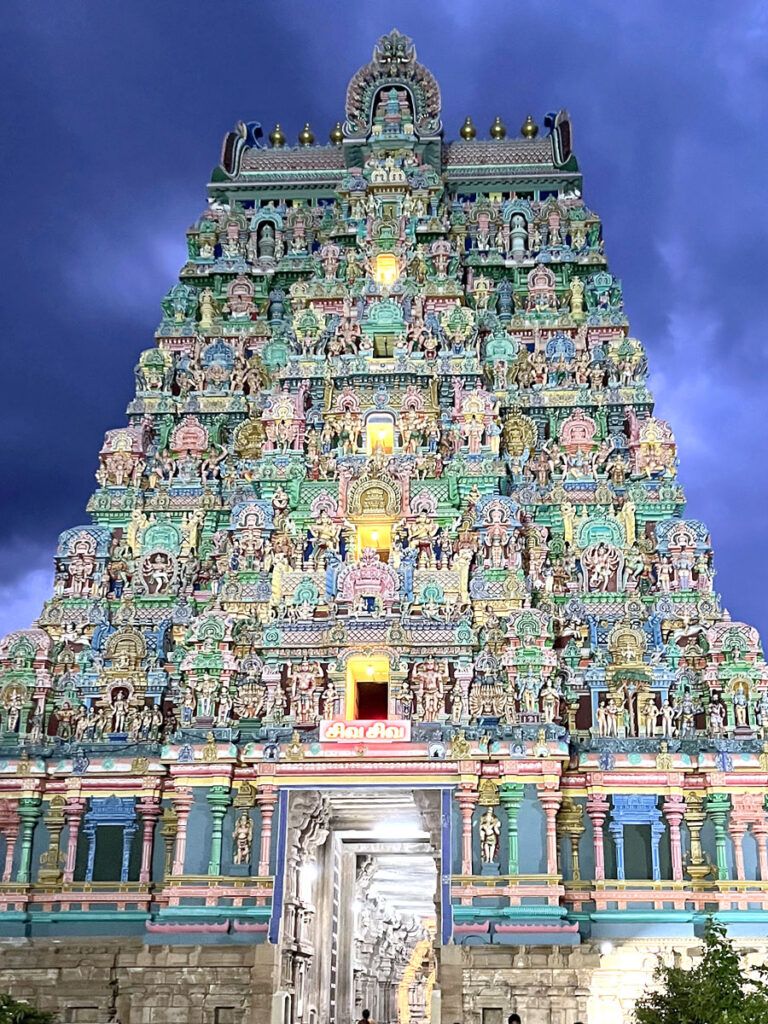
Contents
- 1 Jambukeswarar Temple Thiruvanaikaval History:
- 2 Legend of Jambukeswarar Temple:
- 3 Jambukeswarar Temple Architecture:
- 4 Festivals at Jambukeswarar Temple:
- 5 Significance of Jambukeswarar Temple:
- 6 Jambukeswarar Temple Timings and Pooja:
- 7 Places to visit near Jambukeswarar Temple:
- 8 FAQ:
- 8.0.1 Where is the Jambukeshwarar Temple located?
- 8.0.2 What is the Jambukeshwarar Temple known for?
- 8.0.3 What is the significance of the Jambukeshwarar Temple?
- 8.0.4 What are some of the miracles associated with the Jambukeshwarar Temple?
- 8.0.5 What are the temple timings?
- 8.0.6 What are the entry fees?
- 8.0.7 What are the dress code requirements?
- 8.0.8 What are some of the things to see and do at the Jambukeshwarar Temple?
- 8.0.9 What are some of the best places to stay near the Jambukeshwarar Temple?
- 8.0.10 What is the Speciality of Jambukeswarar Temple?
- 8.0.11 How big is the Jambukeswarar Temple?
- 9 How to reach Jambukeswarar Temple Thiruvanaikaval:
- 10 Google Maps:
Jambukeswarar Temple Thiruvanaikaval History:
The temple is believed to have been built by the early Cholas, around 1,800 years ago. According to legend, a spider once killed an elephant. As a punishment for this sin, the spider was reborn as a king named Kochengot Chola. The king was a pious man, and he built many temples, including the Jambukeshwarar Temple.
The temple has been renovated and expanded several times over the centuries. The most recent renovation was completed in 2009.
Legend of Jambukeswarar Temple:
According to the legend, a spider and an elephant were enemies. The elephant would always destroy the spider’s web, and the spider was enraged. One day, the spider entered the elephant’s ear and bit it. The elephant died, and the spider was also killed.
The goddess Parvati was angry with the spider for killing the elephant. She cursed the spider to be born as a human in the next life. The spider was born as a king named Kochengot Cholan.
Kochengot Cholan was a devout devotee of Lord Shiva. He built a temple for Lord Shiva in Thiruvanaikaval. The temple was built around a sacred jamb tree, which is said to have grown from the spider’s web.
Lord Shiva was pleased with Kochengot Cholan’s devotion. He forgave the spider for its sins and granted it moksha, or liberation.
The legend of the spider and the elephant is a reminder that even the smallest creatures can be important. It is also a reminder that even the most devout devotees can make mistakes. However, with Lord Shiva’s grace, all sins can be forgiven.
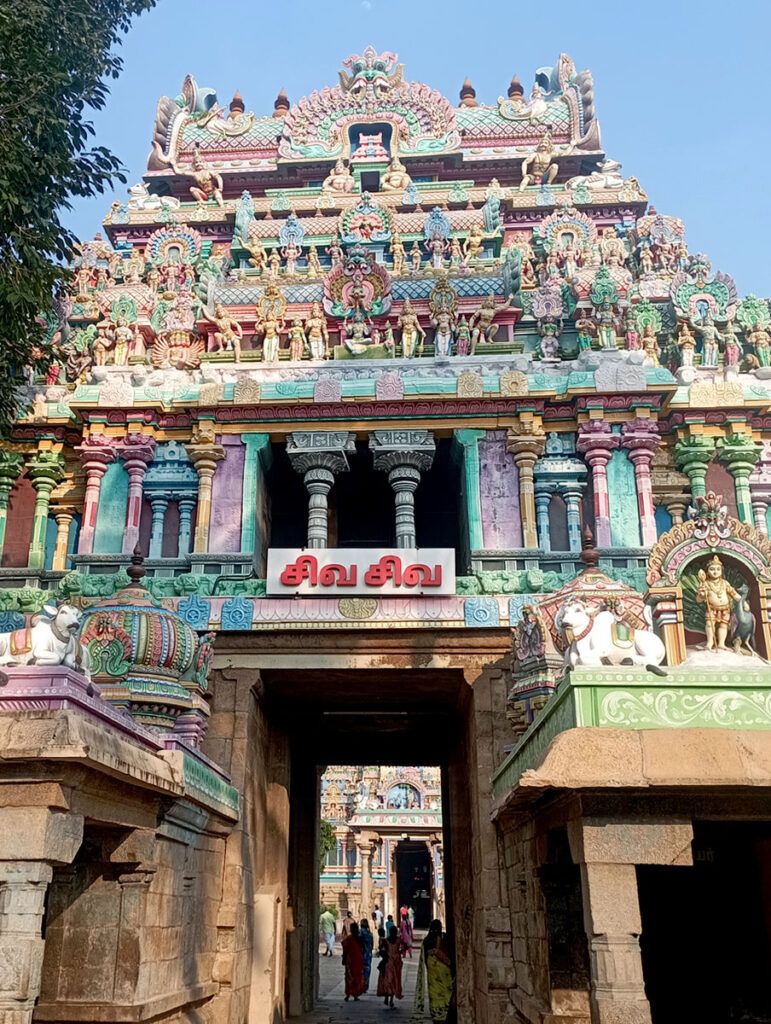
Jambukeswarar Temple Architecture:
The Jambukeshwarar Temple is a large and impressive structure. The main temple is built in the Dravidian style of architecture. The temple is surrounded by a moat and a wall.
The main shrine of the temple is dedicated to Lord Shiva. The Shiva lingam in the shrine is made of black stone. The lingam is bathed in water from the nearby Jambu River.
The temple also has shrines dedicated to Parvati, Ganesha, Murugan, and other Hindu deities.
Festivals at Jambukeswarar Temple:
The most important festival at the Jambukeshwarar Temple is the Panguni Brahmotsavam, which is held in the Tamil month of Panguni (March-April). The festival lasts for 48 days and includes a variety of events, such as processions, pujas, and cultural performances.
Other important festivals at the Jambukeshwarar Temple include:
- The Vaikasi Brahmotsavam, which is held in the Tamil month of Vaikasi (May-June).
- The Navaratri Festival, which is held in the Tamil month of Purattasi (September-October).
- The Thai Theppam Festival, which is held in the Tamil month of Thai (January-February).
The Panguni Brahmotsavam is the most popular festival at the Jambukeshwarar Temple. It is a time for great celebration and devotion, and it attracts pilgrims from all over India. The festival begins with a flag-hoisting ceremony, followed by a series of processions, pujas, and cultural performances.
The processions are one of the most important events of the Panguni Brahmotsavam. The processional deities, including Jambukeshwarar and Akhilandeswari, are taken around the temple complex on a decorated chariot. The processions are accompanied by music, dancing, and fireworks.
The pujas are another important part of the Panguni Brahmotsavam. Special pujas are performed to the deities throughout the festival. These pujas are believed to bring blessings to devotees.
The cultural performances are also a popular part of the Panguni Brahmotsavam. There are a variety of performances, including classical dance, music, and drama. These performances are a way for devotees to celebrate their faith and culture.
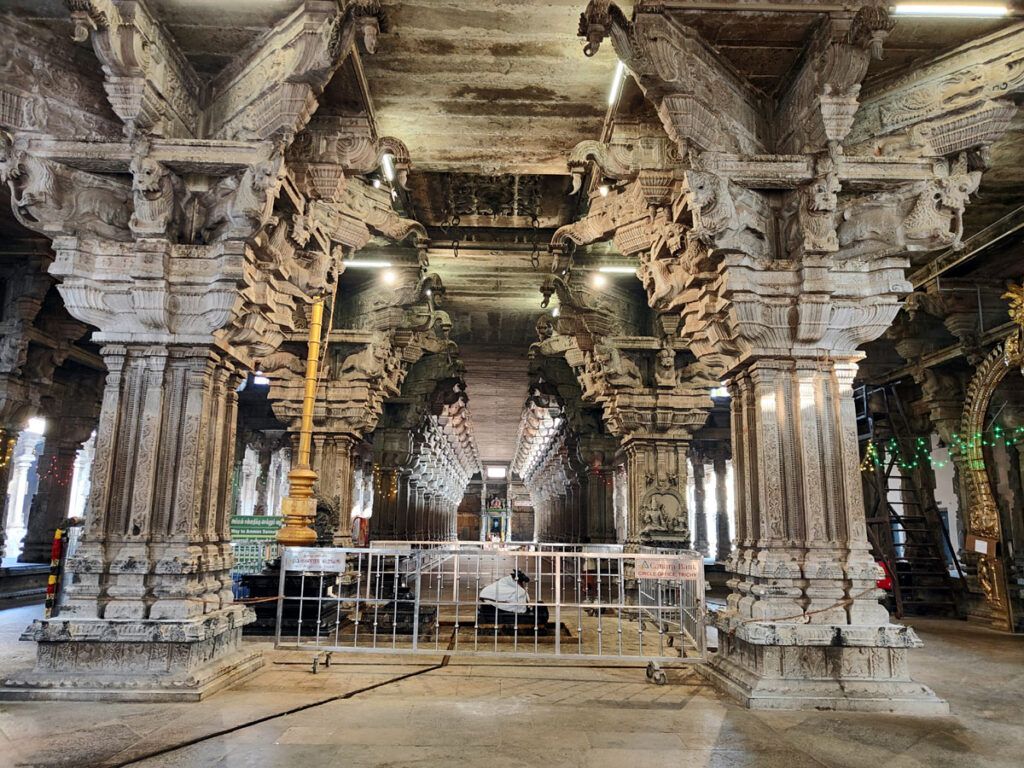
Significance of Jambukeswarar Temple:
Historical Significance
The Jambukeswarar Temple boasts a rich history dating back to the Chola dynasty, with its initial construction attributed to King Kocengannan around the 2nd century CE. Its name is derived from the legend of a celestial elephant, Airavata, who worshipped Lord Shiva under a jambu (jambul) tree, leading to the temple’s consecration.
Significance as a Pancha Bhoota Sthalam
The Jambukeswarar Temple is one of the five sacred Pancha Bhoota Sthalams, each representing one of the five primary elements of nature: earth, water, fire, air, and space. The temple’s unique feature is the continuous flow of water from an underground spring, believed to be divinely ordained. This perpetual flow symbolizes the ever-flowing nature of Lord Shiva’s blessings and the temple’s sacred connection to the element of water.
Architectural Marvel
The Jambukeswarar Temple is an architectural marvel, showcasing the craftsmanship of the Chola era. The temple complex comprises multiple shrines, towering gopurams (gateway towers), and intricate sculptures. The sanctum sanctorum, where the main deity, Jambukeswara, resides, is adorned with exquisite carvings and is surrounded by a sacred water tank.
Devotional Practices and Festivals
The Jambukeswarar Temple is a vibrant center of devotion, drawing pilgrims from across the country. Devotees perform abhishekam (sacred bathing) of the deity, offer prayers and offerings, and seek blessings for various aspects of their lives. The temple hosts several festivals throughout the year, including the grand annual chariot festival, which attracts thousands of devotees.
Cultural and Spiritual Importance
The Jambukeswarar Temple holds immense cultural and spiritual significance. It is considered one of the most sacred Shiva temples in South India and is revered for its divine power and the numerous miracles associated with it. Devotees believe that worshipping at the temple can bestow blessings, purify their souls, and lead them on the path of spiritual enlightenment.
Some of the notable features of the temple are:
- The Jambu River: The Jambu River is a sacred river that flows near the temple. The river is believed to have healing powers.
- The Nandi statue: The Nandi statue is a large bronze statue of Nandi, the bull mount of Lord Shiva. The statue is located in front of the main shrine.
- The dancing hall: The dancing hall is a large hall where the temple priests perform traditional dance and music.
- The sacred tank: The sacred tank is a large tank where devotees can take a holy dip.
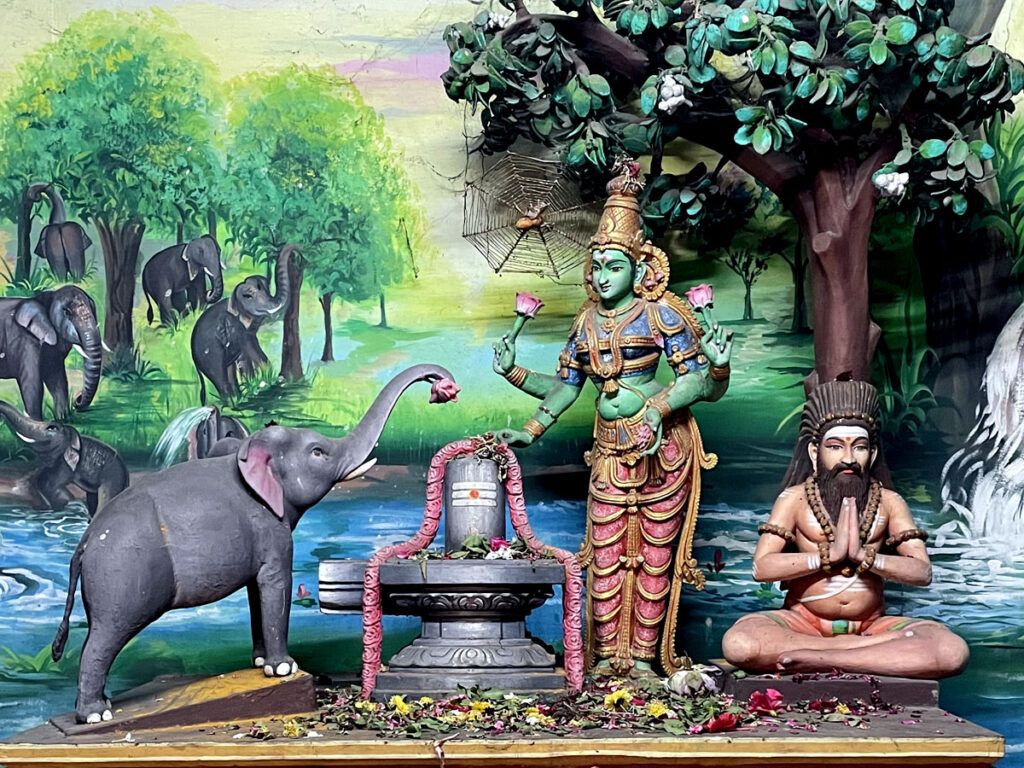
Jambukeswarar Temple Timings and Pooja:
The temple is open from 5:30 am to 1:00 pm and 3:00 pm to 8:30 pm. The main poojas performed in the temple are:
- Usha Kala Pooja: This pooja is performed in the morning at 5:30 am. It is a special pooja dedicated to Lord Shiva.
- Kaalasanthi Pooja: This pooja is performed in the afternoon at 3:00 pm. It is a special pooja dedicated to Goddess Parvati.
- Aaradhana Pooja: This pooja is performed in the evening at 7:00 pm. It is a special pooja dedicated to Lord Shiva and Goddess Parvati.
- Aadi Pooram: This festival is celebrated in the month of Aadi (July-August). It is a 10-day festival that includes a number of processions and rituals.
- Navarathri: This festival is celebrated in the month of Ashwayuja (September-October). It is a 9-day festival that honors the nine forms of Goddess Durga.
Places to visit near Jambukeswarar Temple:
- Sri Ranganathaswamy Temple, Srirangam: This is one of the most famous temples in the region and is dedicated to Lord Ranganatha, a form of Lord Vishnu. It’s located on an island in the Cauvery River and is just a short drive from Thiruvanaikaval.
- Rock Fort and Thayumanaswamy Temple: The Rock Fort complex has a historic fort and a temple dedicated to Lord Shiva. It offers panoramic views of the surrounding area and is a popular spot for both religious and tourist visits.
- Sri Jambukeshwara Akhanda Sundara Kandam: This temple is situated near the Jambukeswarar Temple and is dedicated to Lord Hanuman. It is known for its association with the Sundara Kandam of the Ramayana.
- Mukkombu Dam: If you enjoy spending time outdoors, Mukkombu Dam is a short drive from Thiruvanaikaval. It’s a great place for a relaxing picnic and offers boating facilities.
- Tiruchirapalli Railway Junction: If you’re interested in history and architecture, the Tiruchirapalli Railway Junction is known for its unique blend of Gothic and Dravidian architectural styles.
- Vayalur Murugan Temple: This temple is dedicated to Lord Murugan and is known for its serene surroundings. It’s a peaceful place to visit if you’re interested in exploring more religious sites.
- Rajagopalaswamy Temple, Mannargudi: While a bit farther away, this temple is famous for its grand architecture and intricate carvings. It’s dedicated to Lord Krishna and is worth a visit if you have the time.
- Kallanai Dam: Also known as the Grand Anicut, this ancient dam built across the Cauvery River is a marvel of engineering and a great place for nature lovers.
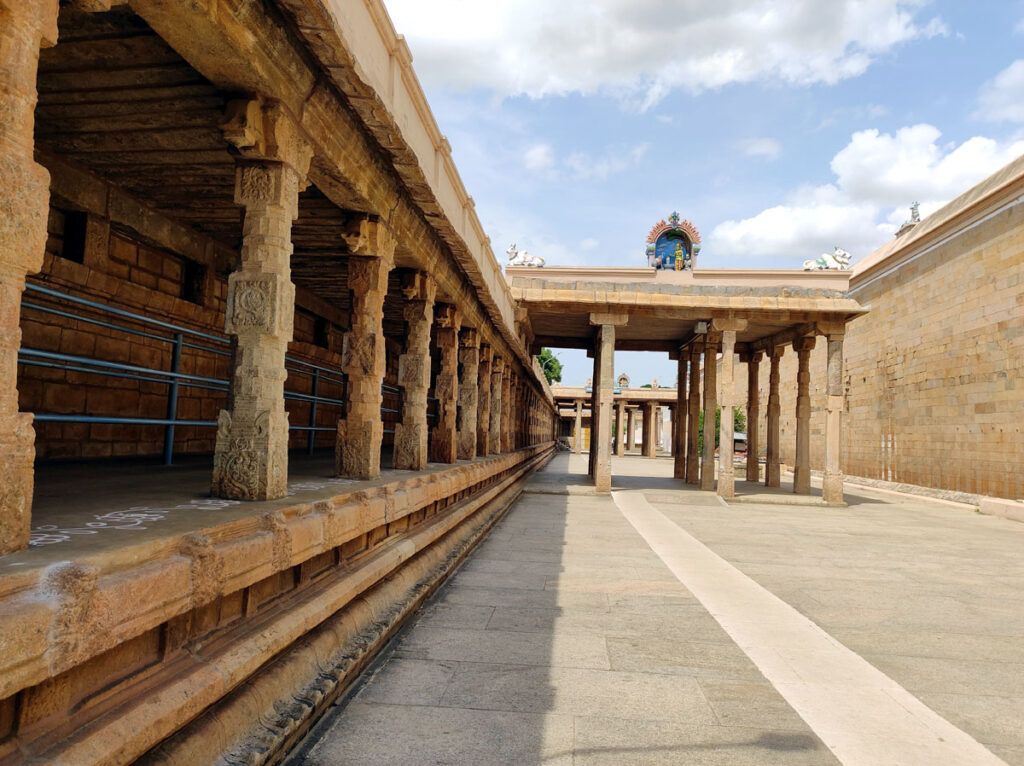
FAQ:
Where is the Jambukeshwarar Temple located?
The Jambukeshwarar Temple is located in Thiruvanaikaval, a town in the Trichy district of Tamil Nadu, India. It is about 15 kilometers (9.3 miles) from Trichy, the famous Hindu pilgrimage site.
What is the Jambukeshwarar Temple known for?
The Jambukeshwarar Temple is one of the most sacred Hindu temples dedicated to Lord Shiva. It is believed to be one of the five Panchabhoota Sthalams, which represent the five elements of nature. The temple is also known for its many miracles, which are said to have occurred over the centuries.
What is the significance of the Jambukeshwarar Temple?
The Jambukeshwarar Temple is significant because it is one of the five Panchabhoota Sthalams, which represent the five elements of nature. The temple represents the element of water, and the presiding deity, Lord Shiva, is known as Jambukeshwarar, which means “Lord of the Jambu Tree.”
What are some of the miracles associated with the Jambukeshwarar Temple?
The temple is known for the following miracles:
- The underground water stream: The sanctum sanctorum of the temple has an underground water stream that flows continuously. The water is said to have medicinal properties and is believed to cure diseases.
- The talking Shiva Lingam: There is a legend that the Shiva Lingam in the temple once spoke to a devotee. The devotee was a great devotee of Lord Shiva, and he had been praying for a child for many years. One day, he heard a voice from the lingam that said, “Do not worry, you will have a child soon.” The devotee was overjoyed, and he went back to his village. A few months later, his wife gave birth to a son.
- The floating camphor: There is a tradition in the temple that devotees can offer camphor to Lord Shiva. The camphor is placed in a small dish and then floated on a bowl of water. If the camphor floats, it is said to be a sign of Lord Shiva’s blessing. If the camphor sinks, it is said to be a sign that the devotee needs to do more penance.
What are the temple timings?
The temple is open from 5:30 AM to 12:30 PM and 3:00 PM to 8:30 PM, every day of the year.
What are the entry fees?
The entry fee for the temple is INR 25 for adults and INR 15 for children. There is also a special fee for those who want to perform pujas and other rituals.
What are the dress code requirements?
Devotees are expected to wear modest clothing that covers their shoulders and knees. Men should also wear a dhoti or a lungi.
What are some of the things to see and do at the Jambukeshwarar Temple?
Some of the things to see and do at the Jambukeshwarar Temple include:
- Visiting the shrine of Lord Shiva
- Seeing the underground water stream
- Touching the Shivalinga
- Offering camphor to Lord Shiva
- Whispering a secret in the whispering archways
- Taking a holy dip in the temple tank
What are some of the best places to stay near the Jambukeshwarar Temple?
There are many hotels and guesthouses to choose from near the Jambukeshwarar Temple. Some of the popular options include:
- Hotel Sri Maha Vishnu
- Hotel Krishna Palace
- Hotel Uma Residency
- Hotel Sri Govinda Vilasam
- Hotel Sri Venkateswara
What is the Speciality of Jambukeswarar Temple?
Here are some of the unique features that make the Jambukeswarar Temple truly special:
- Underground Water Stream: The sanctum sanctorum of the temple houses a remarkable underground water stream that flows continuously around the sacred Shiva lingam. This mystical phenomenon has never been explained, and the source of the water remains a mystery.
- Five Prakarams: The temple complex encompasses five concentric courtyards, known as ‘prakarams’, each representing a different element of the universe. The inner sanctum sanctorum lies at the heart of these prakarams, symbolizing the convergence of all elements in the presence of Lord Shiva.
- Akilandeswari Shrine: The temple also houses a magnificent shrine dedicated to Goddess Akilandeswari, the consort of Lord Shiva. She is revered as the embodiment of divine power and knowledge, and her shrine is a popular pilgrimage destination for devotees seeking blessings and spiritual enlightenment.
- Architectural Grandeur: The Jambukeswarar Temple is a masterpiece of Dravidian architecture, characterized by its towering gopurams (gateways), intricate carvings, and sculptures that depict various Hindu deities and mythical creatures. The temple’s architecture reflects the rich cultural heritage and artistic traditions of Tamil Nadu.
- Paadal Petra Sthalam: The Jambukeswarar Temple is revered as one of the 275 Paadal Petra Sthalams, temples glorified in the devotional hymns of the Tamil Saivite saints known as Nayanars. These hymns, composed between the 6th and 9th centuries AD, extol the spiritual significance of the temple and its presiding deity.
How big is the Jambukeswarar Temple?
The Jambukeswarar Temple in Thiruvanaikaval is a vast and expansive temple complex, covering an area of approximately 24 acres. The temple’s dimensions are as follows:
- Length: 620 feet (189 meters)
- Width: 420 feet (128 meters)
The temple’s five concentric courtyards, known as ‘prakarams,’ contribute significantly to its overall size and grandeur. These prakarams enclose the inner sanctum sanctorum, where the sacred Shiva lingam resides.
Here’s a breakdown of the size of each prakaram:
- First Prakaram: 510 feet (155 meters) by 350 feet (107 meters)
- Second Prakaram: 440 feet (134 meters) by 260 feet (79 meters)
- Third Prakaram: 370 feet (113 meters) by 200 feet (61 meters)
- Fourth Prakaram: 2436 feet (743 meters) by 1493 feet (455 meters)
How to reach Jambukeswarar Temple Thiruvanaikaval:
By Air:
The nearest airport to Thiruvanaikaval is Tiruchirapalli International Airport (TRZ). From the airport, you can hire a taxi or use other local transportation to reach the temple.
By Train:
Tiruchirapalli Junction (Trichy Junction) is the nearest major railway station. From the railway station, you can take a taxi or use local transport to reach Thiruvanaikaval.
By Road:
- Local Transport:
- Thiruvanaikaval is well-connected by local buses and auto-rickshaws from various parts of Tiruchirapalli.
- You can also hire a taxi or use app-based ride services to reach the temple.
- Personal Vehicle:
- If you’re driving, you can use GPS navigation services like Google Maps to reach Thiruvanaikaval. The temple is well-marked on most maps.
- The temple is located about 5 kilometers east of the central part of Tiruchirapalli.
Tips:
- It’s advisable to check for the latest travel information and road conditions before planning your visit.
- If you are unfamiliar with the local language, it might be helpful to have the temple’s name written in Tamil (திருவானைக்காவல்) to facilitate communication with locals.

3 Comments